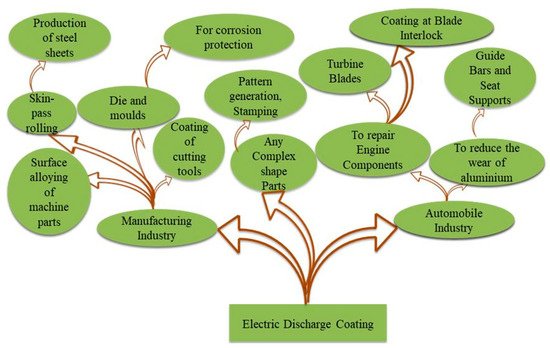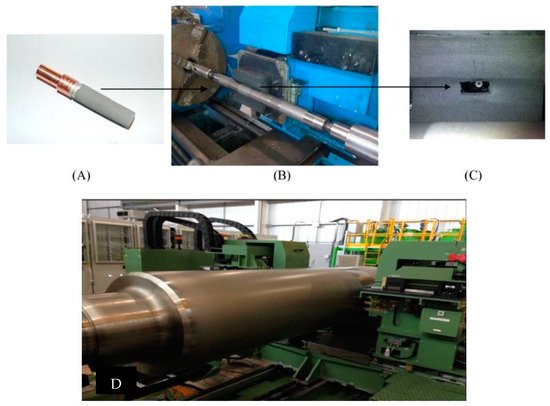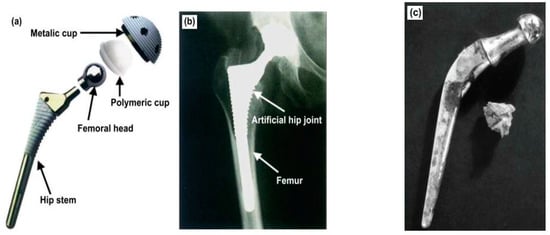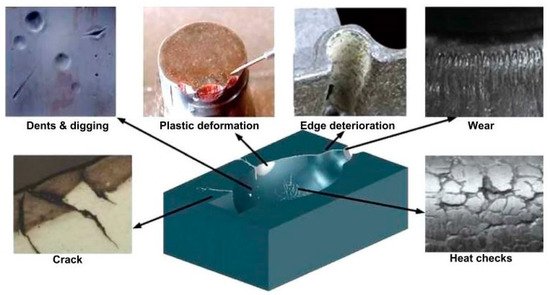You're using an outdated browser. Please upgrade to a modern browser for the best experience.
Please note this is an old version of this entry, which may differ significantly from the current revision.
Subjects:
Materials Science, Coatings & Films
Electrical discharge coating (EDC) process is used to deposit material on workpiece surface from sacrificial or green compact tool electrode in an electrical discharge machine. Electrical discharge coating is an advanced and simple coating process that is applied for conductive materials due to the certain advantages, i.e., good adhesion among the parent material and coating, high efficiency to achieve thick coating, and ability to balance the composition of coated layer by using proper tool electrode material and dielectric fluid
- surface modification
- coating
- EDM
- EDC
1. Introduction
There are various surface-coating technologies used currently, including electroplating, laser cladding, physical vapor deposition, and plasma spraying [9]. However, EDC is yet not widely employed by industries, even though many studies have highlighted its functions in different sectors and applications, as shown in Figure 23. EDC has a large range of applications in both the automotive and manufacturing industry. In the manufacturing field, surface modification through EDC is employed in electrical discharge texturing or roll texturing. In addition, it is extensively used in automotive industries in reducing the wear of aluminum and its alloys used in the aerospace and automobile industries [96]. Surface alteration is also applied successfully in a tool, die, and mold manufacturing industry; turbine blades making; automotive industry; and in other many industrial applications [167]. On the other hand, it can be applied in a coating on cutting tools to enhance its cutting performance and life, aa well as the surface alloying of dies, molds, and machining parts [168]. These applications are discussed in detailed below.

Figure 23. Recent applications of EDC.
2. In Roll Surface Texturing
Roll texturing is also named as the electric discharge texturing (EDT) process, which is one of the EDC applications. Roll texturing was used to deposit a hard particle of compact tool (Ti/W/Cr) onto the roll surface due to the electrical spark formed between a compact tool and roll. The industrial temper mill work rolls are one of the examples of roll texturing where the concept of EDC is employed. EDT is carried out by shot blasting and cross-grinding. It was observed that higher concentrations of W and Ti get deposited at the roll surface. The microhardness was due to the presence of hard carbides of W and FeC. The process of texturing of Sendzimir rolls through electrical discharge is also applied for the production of steel sheets. The hardness of the workpiece increases with improvement in its performance and the life cycle of the roll in roll texturing [8]. The electrical discharge coating was also employed with TiC-sintered tool to analyze the microhardness, coating thickness, surface roughness, and wear performance of the coated layer deposited on the roll surface. It was desirable for the better service life of the roll for industrial applications for consistent control of the surface texture. The method of skin-pass rolling was used for the evaluation of steel sheet surface texture by maintaining the roll surface topography. The effect on the clarity of coating and formability of the sheet press was studied. A hard layer was formed by EDC with a TiC electrode, which showed a Vickers hardness of greater than HV1500 and controllable surface roughness. The wear of coated rolls generated was greater than chrome-plated rolls [92]. Further, EDC was applied on A2 steel and over the temper mill roll by using the cemented tungsten carbide electrode as shown in Figure 24 [169].

Figure 24. (A–C) EDC surface bands on A2 steel and (D) EDC over temper mill roll [169].
3. To Repair the Turbine Blade
Thick EDC, which is known as “MS coating”, is applied to repair components. Conventionally, in the repair process of airplane engines, surface modification or cladding methods, such as plating, welding, or metal spray, are used. As an example of application of microspark coating, the sample is used in the low pressure turbine (LPT) blade interlock of the airplane engine [21,23].
4. Pattern Generation and Stamping
By using reverse EDM and by changing the process parameters, it is possible to produce the complex-shaped pattern [170,171]. Recently, a green compact tool was used to generate a predefined pattern by depositing its constituent materials [172]. EDC is also known as “MS coating” by which marks of two companies are stamped. It can be observed that even the edges of marks can be stamped clearly without masking [21,23].
5. In Guide Bars, Seat Supports/Bearing Plates
The metal weight and its quality have an important role in aerospace industries. Aluminum and its alloys have attracted attention in the automotive industry owing to the high specific strength and lightweight properties such that it can replaced steel. There is a variety of applications of aluminum alloys that have been used in the automotive industry to improve the tribological performance of [173]. Aluminum and its alloys suffer erosion due to the effect of airborne particles; hence, a coating is an effective way to overcome its erosion. To provide these qualities, EDC becomes an effective technique in terms of the coating.
6. In Die and Mould Coating
Other various vital industrial applications include manufacturing of mold, die, and turbine blades to prevent the defects as shown in Figure 25 [174,175]. EDC provides a hard and corrosion-resistant layer without changing the properties of the original material, which has broadened its application in die, tools, molds, turbine blades, etc. as they erode due to corrosion. Researchers reported that the life of molds and cutting tools can be enhanced by applying EDC coating using a Ti or TiC electrode [141,142,176].
7. In the Biomedical Field
The application of EDM has also been extended up to orthopedic implants due to involvement of a new technology in which dielectric fluids are mixed with certain additives i.e., powders of metal, surfactant, and different types of gases. It comprises mixing the liquid dielectric with some additives, for example, surfactant, metal powders, oxygen, and nitrogen gasses, which have extended the applications of EDM. Apart from enhancing the resistance to wear and corrosion, the mixing of additives has immensely helped in enhancing the mechanical properties and fatigue life of orthopedic implants [177,178]. Further, the applications of additive mixed process help to prepare the biocompatible and nanoporous coating film over the machined implant surface [115,179]. Figure 26 shows the artificial hip joint and corrosion occurred after implantation [180,181]. In summary, the EDC has an excellent contribution to modify the material surface and functionalization for biomedical applications [178,182,183,184]. With the help of EDC process, the biocompatibility of artificial implants can be upgraded by the cells’ attachment and proliferation [185,186].

This entry is adapted from the peer-reviewed paper 10.3390/pr10101971
This entry is offline, you can click here to edit this entry!

